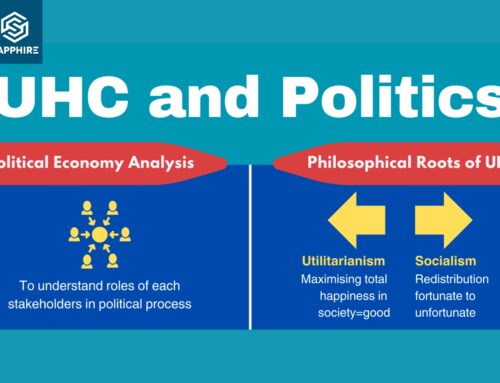
The COVID-19 pandemic has required that countries prioritise public health interventions for disease surveillance, prevention and control of recurring outbreaks. Although the global pandemic response has been guided by important pharmaceutical and non-pharmaceutical interventions, these have been applied differently within and across countries and regions. On one hand, they may be regarded as having context specific responses corresponding to individual country’s needs and dynamic situations, and that some useful lessons from one country maybe sharable and applicable to another. Yet, on the other hand, the fragmentation in these responses could have a significant impact on the spread of infection, the rise of new virus variants and resulting economic and social restrictions. This pandemic reminds us of the need for collaborative regional efforts to tackle infectious disease threats both in our current crisis and as we prepare for others in the future.
Contributing to this discussion, the National University of Singapore (NUS) and the Health Intervention and Technology Assessment Program (HITAP), Ministry of Public Health, Thailand, are conducting an academic research study titled “Southeast Asia Centre for Infectious Disease Control (SEACID)” through which the team will review regional and global infectious disease networks across the world to identify key lessons learned from these examples. The results of this academic study can support the operationalisation of similar entities at the regional level in Asia.
Background
The Asian region is no stranger to disease outbreaks, having suffered the Avian Influenza A (H5N1) in 2003, Severe Acute Respiratory Syndrome (SARS) in 2003, New Influenza A (H1N1) in 2009, Middle East Respiratory Syndrome (MERS) in 2012, and Zika in 2015-2016. Each of these health emergencies have caused widespread devastation to health and livelihoods, re-emphasising that national borders are of little consequence to the spread of infectious diseases or in ensuring an effective response, and that one nation alone cannot be fully safe and secured from such threats unless its neighbours are. The absence of a unifying public health body in a region to help guide a concerted response has been of note in the past, reaffirmed by the COVID-19 pandemic.
What are we looking for in our review?
The scoping review, titled the “Operationalising regional cooperation for infectious disease control: a scoping review of regional disease control bodies and networks”, draws on lessons learned from collaborative agencies such as the Pan American Health Organisation (PAHO), European Centres for Disease Prevention and Control (ECDC), Africa Centres for Disease Control and Prevention (Africa CDC) and others, to support the operationalisation of regional public health entities or health collaborative networks .
However, recognising that each regional body may be different in many of the structural and contextual underpinnings, the review assimilates some generalisable insights that could be adopted in other region such as in Asia, with details that might be useful to the set-up and workings of regional health bodies in Asia. The review will also be bolstered by discussions with representatives from regional organisations in Asia and around the globe. This approach will allow learning from a richer set of experiences, guided by their dynamic roles and long history of establishment.
The review focuses on seven dimensions of regional health collaboration – networks, organisation factors, programming, diagnosis and detection, human resources, communication, and sustainability and funding. In each of these dimensions, we identify barriers and enablers, later synthesising these into lessons learned.
What have we learned so far?
So far, our research has been able to provide evidence to suggest that determinants, such as governance and financing support, are fundamental in operationalising transnational mechanisms of health policy making and response. The impact of such determinants on an important pathway of learning and capacity building plays a pivotal role, in responding to an emergency, and enables collaboration between disciplines as well. However, sustainability of networks should also be ensured, from the stages of their design and development. Importantly, these networks often are significant intermediaries in evidence-informed health policy decisions, communicating not only with decision-makers but also with the public; all of these elements are vital in mitigating a crisis such as COVID-19 pandemic.
What more will we learn as we go along?
The SEACID study will explore the evidence we have so far gathered in much greater detail, elaborating on examples of existing networks in Asia and other regions, including their roles, challenges, and benefits in addressing infectious disease threats. We hope this research effort provides an indication on the relevance of academic discourse in facilitating policy making, and expands the scope of collaborative efforts, within the broader realm of global health security preparedness.
We look forward to sharing with you all the full results of our review, which will be available over the coming months.
Acknowledgments
The SEACID research study is led by the National University of Singapore (NUS) and is conducted in collaboration with the Health Intervention and Technology Assessment Program (HITAP). The study is funded by the Health Systems Research Institute (HSRI). The authors would like to acknowledge all members of the scoping review team including Assoc. Prof. Natasha Howard (NUS), Anna Durrance-Bagale, Manar Marzouk, Sunanda Agarwal, Sarah Gan, Michiko Hayashi, Beth Jacob-Chow, Jiayun Koh, Sze Tung Lam, Hala Mkhallalati, Sanjida Newaz, Maryam Omar, Mengieng Ung, Yuze Yang, Assoc. Prof, Li Yang Hsu, and others in the SEACID research initiative for their support and guidance.



